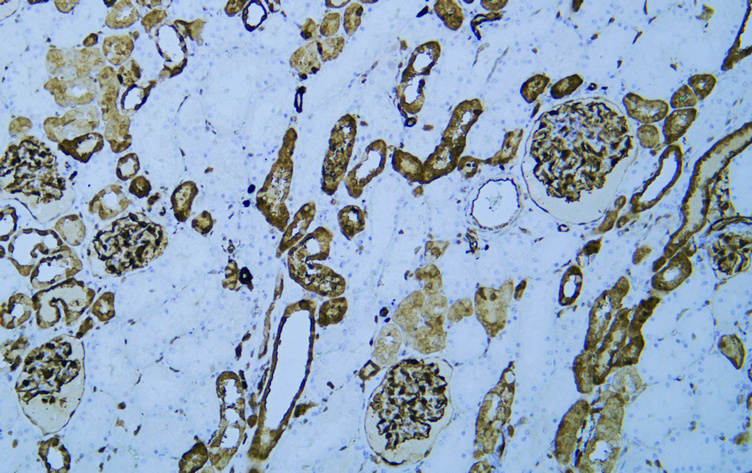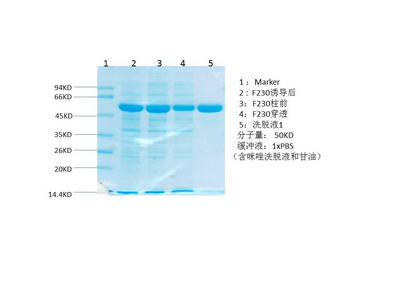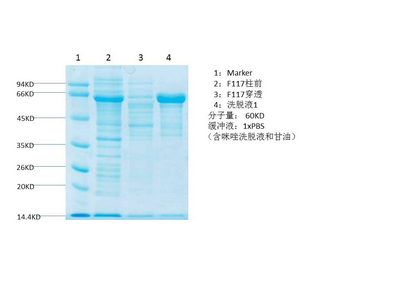
Catalog: YD0089
Size
Price
Status
Qty.
100μg
$280.00
3 weeks
0
Add to cart


Collected


Collect
Main Information
Reactivity
Human
Applications
WB, SDS-PAGE
Detailed Information
Formulation
Liquid in PBS
Purity
SDS-PAGE >90%
Storage
-20°C/6 month,-80°C for long storage
Related Products
Antigen&Target Information
Sequence:
Amino acid: full length, with his-MBP tag.
show all
Gene Name:
S100 β
show all
Protein Name:
S100 Beta protein
show all
Other Name:
Protein S100-B ;
S-100 protein beta chain ;
S-100 protein subunit beta ;
S100 calcium-binding protein B ;
S-100 protein beta chain ;
S-100 protein subunit beta ;
S100 calcium-binding protein B ;
show all
Background:
function:Weakly binds calcium but binds zinc very tightly-distinct binding sites with different affinities exist for both ions on each monomer. Physiological concentrations of potassium ion antagonize the binding of both divalent cations, especially affecting high-affinity calcium-binding sites. Binds to and initiates the activation of STK38 by releasing autoinhibitory intramolecular interactions within the kinase.,miscellaneous:In addition to metal-ion binding, this protein is involved with the regulation of protein phosphorylation in brain tissue.,similarity:Belongs to the S-101 family.,similarity:Contains 2 EF-hand domains.,subunit:Dimer of either two alpha chains, or two beta chains, or one alpha and one beta chain. The S100B dimer binds two molecules of STK38 (By similarity). The S100B dimer interacts with two molecules of CAPZA1.,tissue specificity:Although predominant among the water-soluble brain proteins, S100 is also found in a variety of other tissues.,
show all
Function:
cell morphogenesis, cell morphogenesis involved in differentiation, axonogenesis, behavior, learning or memory, cell proliferation, cell projection organization, neuron differentiation, neuron projection development, cellular component morphogenesis, cell part morphogenesis, neuron development, cell morphogenesis involved in neuron differentiation,neuron projection morphogenesis, cell projection morphogenesis, neurological system process, cognition,
show all
Cellular Localization:
Cytoplasm . Nucleus .
show all
Tissue Expression:
Reference Citation({{totalcount}})
Catalog: YD0089
Size
Price
Status
Qty.
100μg
$280.00
3 weeks
0
Add to cart


Collected


Collect
Recently Viewed Products
Clear allPRODUCTS
CUSTOMIZED
ABOUT US
Toggle night Mode
{{pinfoXq.title || ''}}
Catalog: {{pinfoXq.catalog || ''}}
Filter:
All
{{item.name}}
{{pinfo.title}}
-{{pinfo.catalog}}
Main Information
Target
{{pinfo.target}}
Reactivity
{{pinfo.react}}
Applications
{{pinfo.applicat}}
Conjugate/Modification
{{pinfo.coupling}}/{{pinfo.modific}}
MW (kDa)
{{pinfo.mwcalc}}
Host Species
{{pinfo.hostspec}}
Isotype
{{pinfo.isotype}}
Product {{index}}/{{pcount}}
Prev
Next
{{pvTitle}}
Scroll wheel zooms the picture
{{pvDescr}}

















